Surface feeding pelagics bring an unequalled level of excitement to anglers all across our country.
A lot of the appeal comes with the visual impact and the challenges associated with trying to fool fish you can see feeding – nothing in the angling world really compares.
This time of year harbours, bays and lower estuaries along the east coast come to life with small baitfish anglers refer to as ‘eyes’. They turn up in huge schools and enter the inshore waters to feed and seek shelter.
Unfortunately most don’t get an opportunity to do either, because they are herded up on the surface and devoured by ravenous schools of salmon, tailor, kingfish, bonito and silver trevally.
The easiest method to locate surface feeding activity is to watch for gulls and especially terns, which should be hovering very close to the surface or diving repeatedly to indicate feeding activity from pelagics below.
Early and late in the day are the best times to spot these flocks from greater distances, because the low angle of the sun reflects off the birds’ wings, similar to the way the sun glints off someone’s wristwatch.
Gulls also tend to sit in large flocks on the surface and can be a sign of prior surface activity. A few prospective casts in their general direction are never unwarranted; all bird activity should be investigated and ruled out before moving on.
It’s easy to get all excited and rush up on these active schools of fish but that will most likely lead to the school being spooked and going deep, ruining the fun for everyone.
Taking the time to observe the behaviour and direction of the school is highly advantageous for your crew and the other anglers who will invariably be cashing in on the same action.
The technique is to pick which way the school is working; the fish will generally push into the wind and/or current.
With this in mind, you should position your boat well upwind/current and kill the engine. Let the fish come to you and then cast. Let the school pass by before starting the engine and take a wide berth around the fish and head back to the upwind/current side.
At times you can have fish busting up all around the boat and at other times the bait may use your vessel for cover and you turn into a mobile FAD (fish aggregating device).
Trollers, be warned: It is not appropriate to tow your lures through the middle of any bust-up. Pick your line and work the edge of the school so as to not spook and send the schools down deep, shutting them down.
At times it is hard to see what the fish are feeding on; it may look as if they are gulping air. If you find it hard to observe the bait spraying on the surface, it would be fair to assume that the bait is microscopic and lure selection should be made accordingly.
‘Eyes’ can range from 10mm to around 75mm, so it pays to a have a few lures in your kit that can ‘match the hatch’ when these situations occur.
Keep a selection of 3g-25g metal slices in a range of profiles and colours most commonly used for this style of fishing.
Most of the time, metal slices work best when retrieved flat out but they can also be worked slowly and down deeper.
Fast rips with pauses and slow, constant retrieves while twitching the rod tip are effective at times, too.
Bonito tend to prefer their metal after it has sunk and then retrieved back towards the surface at a rate of knots.
Vertically jigging small metals under the school, or when the fish have gone deep and marking on your sounder, is another method that can keep a bite going.
Silver trevally are commonly caught this way, holding deep and picking off the scraps as they waft down through the water column.
Soft plastics are another great option for targeting surface-feeding schools.
The versatility to swap and change lure profiles, sizes and colours is endless with soft plastics but there are drawbacks, too. They can fall down the on the shank of the jig hook when retrieved briskly, they get damaged easily by toothy critters like tailor and bonito, and they are fiddly to rig dead straight when you have adrenalin running through your veins while fish are busting up all around you.
Those issues aside, the benefits of soft plastics far outweigh the problems.
On particular days the fish will not eat anything other than lightly rigged plastic slowly twitched on the surface. At other times they want it moving as fast as you can wind.
It’s just a matter of seeing which technique will work best on the day.
One of the main benefits of plastics is the ability to modify them to suit the prevalent bait.
It’s quite common the cut down 3” stickbaits to half or one-third of their original length to get a bite when the fish are fussy.
Small poppers and stickbaits also offer another exciting way to extract interest from these fish.
These lures give great visual strikes for anglers but have their problems, too.
Fouling up the trebles is the most common issue with poppers and stickbaits, especially if there is a rough chop on the surface. Low rod angles during the retrieve can help to alleviate this, as can removing the belly treble hook.
There are three main retrieves that draw strikes with poppers and stickbaits.
The first is a slow, constant wind which gets the lure to trace a ‘v’ wake across the surface. It’s often the best approach when fish are spooky.
The second retrieve is more for cup-faced poppers and consists of a series of short stabs with the rod tip to get the popper to bloop continuously. Adding a pause every so often is also deadly.
The third retrieve technique can be used with poppers and stick baits and is commonly known as walking the dog. The angler must time twitching the rod tip with small winds of the reel handle to pick up slack line between twitches.
Once mastered, your topwater offering will dart from side to side, imitating a wounded and confused baitfish.
When these pelagics focus on ‘eyes’ they can be quite hard to tempt on conventional tackle.
The flyline is a great alternative for presenting microscopic flies that replicate the size of the bait. These offerings are rarely refused once the right retrieve is worked out.
Slow and steady strips, figure eights and rapid two-handed retrieves can all work at times, it’s just a matter of seeing which one the fish respond to on the day.
For those of you that don’t have the time or skills for waving the long wand, there is an alternative.
Remove the treble or single hook from a 15g metal slice and attach a short length of fluorocarbon leader material to the rear split ring. To this you attach a small fly that represents the prevalent baitfish.
Using the weight of the metal lure, a tiny fly can then be cast and retrieved great distances on conventional tackle.
I have also come across anglers using small flies below clear bubble floats that can be partially filled with water to add casting weight and a little more finesse to the rig.
It’s always good practice if you are planning an outing in the lower reaches of your local waterway at this time of year to have an outfit rigged and ready in case the above scenario presents itself; it has turned many a slow day around for a lot of anglers out there and has to be experienced to be appreciated.
Facts
SWINGING SINGLES
In recent years I have been removing the standard treble hook that most metal slices come with and replacing it with a single non-offset J-hook. The hook-up to landing ratio is far better when you have species like salmon and tailor that like to get airborne during the fight. The single hook tends to find its mark in the corner of the jaw and is hard to throw, even with the weight of the metal slice working back and forth.
Secondly, catch and release is the only way to go when encountering large numbers of these fish. Salmon aren’t the most highly desirable table fish so the majority are set free. A single hook is far safer for removal and is less damaging to the fish – and humans.
Facts
TACKLE
• Tailor, salmon, bonito and silver trevally: 2kg-4 kg medium-fast action graphite rod, 1000-2500 size threadline reel with 3lb-8lb braid. The 2500 is handy for faster retrieves and bigger fish. Most of this action happens out in open water so bust-offs on structure aren’t common. Just make sure you have a full spool of line.
• Kingfish: 6kg-8kg rod, 4000 size threadline, 15lb-20lb braid.
• Leader 6lb-30lb, determined by what species are about. Fluorocarbon is a no-brainer for low visibility and high abrasion resistance.

When surface pelagics like this salmon are feeding on ‘eyes’ and refusing standard lure presentations, fly-fishing can be very rewarding.
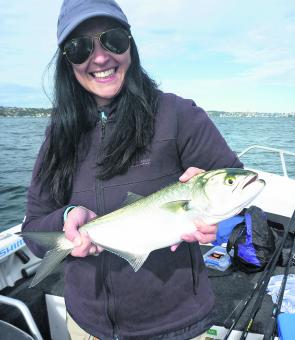
Tailor are great sport and not bad on the plate when fresh. Metal slices and surface lures are the best options when these guys are in attendance, to minimise bite offs and destroyed soft plastics.

Some big kingfish can get in on the action at times. It can pay to have a larger surface lure or plastic rigged and ready on appropriate tackle.

Multiple species can be found hunting together at times. Here bonito and salmon were caught on cut-down soft plastic minnows as a double hook-up.
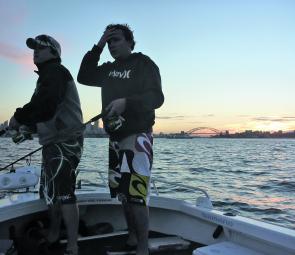
Frustration is all part of the challenge when trying to tempt fussy feeders.
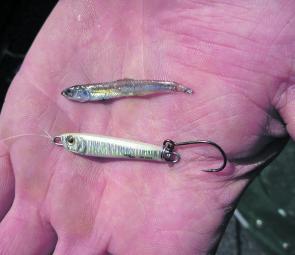
Matching the hatch with this 7g metal slice proved productive on this day. Note the single non-offset J-hook in place of the standard treble.
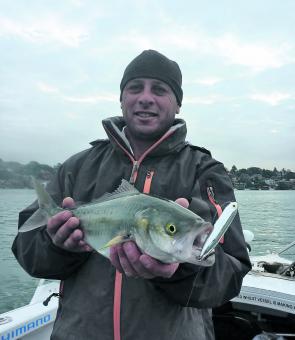
Topwater stickbaits give anglers great visual strikes when the correct retrieve is employed.

Silver trevally tend to hang beneath the active surface schools and can be caught by presenting an offering down deep, where they await any scraps or unwary baitfish.
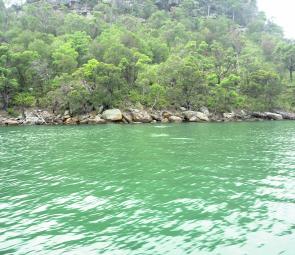
Not all surface feeding activity will be indicated by large numbers of fish busting up. Here a single tern alerted the author to a school of tailor working along the shoreline.
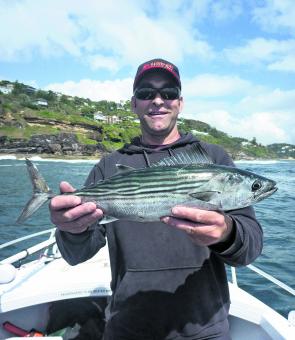
Bonito are exciting targets when feeding on the surface.
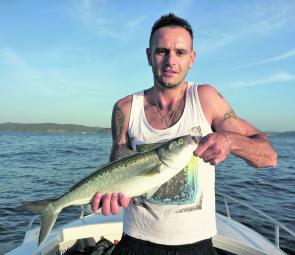
Salmon are the most common species to be found smashing bait on the surface. What they lack in eating quality they sure make up for with blistering runs and aerial antics once hooked.

Having a selection of topwater presentations, soft plastics with matching jig heads and some small metal slices will get you into some hot action this Spring.




